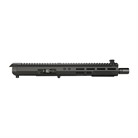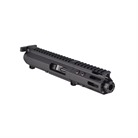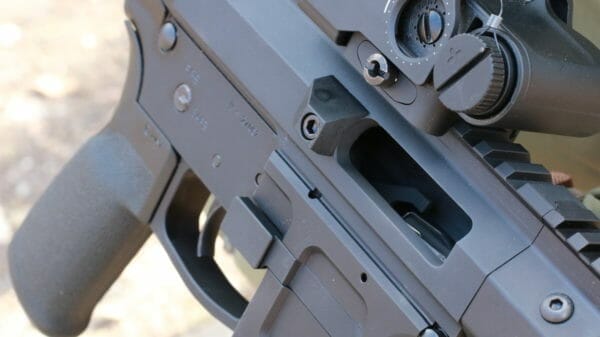U.S.A. – Pistol-caliber carbines, also known as pseudo-sub-guns like the Foxtrot-Mike FM9, have been on the rise in the US commercial market over the last few years – and that’s a good thing. While they lack the range and energy of a rifle-caliber carbine, they are (usually) cheaper to shoot, have low recoil, and have considerably less flash and concussion on shorter barrels compared to SBRs. They make for great training tools, and also make an excellent choice for a home defense firearm or “truck gun”.
But, what is a PCC? Classifying certain firearms can often be like trying to determine the genus or species of some extinct creatures – as they share certain common traits with one another, but can also be quite different in many ways. I consider PCCs to essentially be a firearm that meets two criteria: 1) They fire a (typically) straight-wall semi-auto pistol cartridge, and 2) they have a fore-end and some type of stock or (for NFA reasons in the US commercial market) a pistol-brace. Thus, certain firearms which aren’t exactly pistols – like the MAC10 or Tech-9 – wouldn’t fall into the PCC category. Inversely, some exceptions can be made, such as the FN P90 or H&K MP7, both of which could be considered PCCs that fire unique high-velocity cartridges that are pistol caliber in size but have shouldered casings.
Foxtrot-Mike FM9
Live Inventory Price Checker

|
Foxtrot Mike Products Mike-9 Enhanced Forward Charging Upper Receivers | Brownells.com | $ 379.00 |
|

|
Foxtrot Mike Products FM9 Forward Charging Rifle 9mm 16 Barrel | GrabAGun | $ 799.99 |
|

|
Foxtrot Mike Products FM9 Rear Charging Rifle 9mm 16 Barrel | GrabAGun | $ 799.99 |
|

|
Foxtrot Mike Products Mike-9 Enhanced Pistol Upper Receivers | Brownells.com | $ 299.00 |
|
PCCs are nothing new, really. Many older lever gun carbines which fire cartridges also used in revolvers could arguably be considered the first PCCs. Then we have the venerable Thompson submachine gun in 45 ACP. Then came the German MP40, American grease gun, and British Sten – all World War 2-era sub guns. Then sub-guns like the H&K MP5 and the Israeli Uzi made their appearance in the latter half of the 20th century, and these then evolved into weapons like the P90 and MP7.

In the US commercial market, we have recently seen firearms like (excluding those chambered in 22lr) the Ruger PCC, the Keltec Sub2000, the Beretta Cx4 Storm, and many others. But what would the world and the United States of America be without an AR chambered in a pistol cartridge? A sad place, indeed. Luckily, there are a plethora of manufacturers now making ARs chambered in 9mm, 45 ACP, and other pistol cartridges.
The idea of course is not new. Every 9mm AR you see on the market can trace its lineage back to the Colt Model 635 SMG – the granddaddy of sub-caliber ARs. But, the Colt SMG had its limitations and flaws, and so many companies have sought to improve upon the design. With that, we introduce the Foxtrot-Mike FM9.

Foxtrot Magazines
Whereas the Colt 635 uses a straight 32-round magazine based off the Uzi magazines, the FM9 uses angled double-stack Glock pistol magazines, such as those that come with the Glock 17, 18, 19, and 34. The main reason for this, simply, is logistics. Glock mags are some of the most widely available and prolific magazines on the market, along with their hosts – the 9mm Glock pistols. Anyone who owns a 9mm Glock will already have magazines that can be used in the FM9. Another benefit of using something like an FM9 in place of a long gun, while carrying a Glock pistol as a sidearm, is that the magazines and ammo you carry can be used interchangeably on both platforms.
In my testing, I found that magazines manufactured by both Glock and Magpul ran flawlessly, without a single malfunction. The magazines used in testing were: 17-round Glock 17 gen 5, 31-round Glock 18, 15-round Glock 19 gen 3, 27-round Magpul PMAG GL9, and the 21-round Magpul PMAG GL9. My understanding is that magazines from other manufacturers are hit or miss and may not insert, as the outer dimensions can be slightly larger than the Glocks and Magpuls. So, best to stick with either Glock or Magpul mags for the FM9.

A simple, reliable, and unique design that is offered on the FM9, and which is patented and licensed by Foxtrot-Mike, is truly one of its greatest selling points: the last-round bolt hold-open feature. Anyone familiar with a standard 5.56 AR15 will know that when the magazine runs dry the bolt locks to the rear. This both allows the rifleman to reload the weapon with a single hand, without charging it as you would on an AK, and it gives the rifleman tactile feedback to let him know that the weapon has run out of ammunition. This lowers the amount of time it takes to get the weapon back in action.
The Colt-pattern magazines do facilitate the same bolt hold open mechanics in the guns that use them, like the original Colt SMG, however, the 9mm ARs that use Glock magazines have always had a problem accomplishing last-round bolt hold open, due to the difference in the magazine design and the way it works in pistols. Other 9mm AR manufacturers use springs in the bolt catch/bolt release, but these have always proven to be unreliable.

Foxtrot-Mike solved this problem with their design. A small tab internally in the forward part of the magazine well is actuated by the magazine follower in a similar way as it is in a Glock pistol. This tab is connected to a small transfer rod that sits externally on the lower receiver’s left side, which is then connected to a standard-looking AR bolt catch/bolt release. When the tab is actuated by the follower on an empty magazine, it rotates the transfer rod, which in turn rotates the bolt catch to the up position, which then locks the bolt to the rear.
In all of our testing, with all the different magazines used, the bolt never failed to lock to the rear a single time on an empty magazine. Between this feature and the FM9 using a standard AR charging handle – the FM9 thus has exactly the same manual of arms as a 5.56 AR. For this reason, the FM9 makes for a great substitute training tool for a 5.56 AR, and/or as an excellent choice for a home defense weapon for those (such as military veterans) who are intimately familiar with the AR rifle but prefer to not use a full-power rifle cartridge for the task of home defense.

Dedicated 9mm Lower Receiver
One of the greatest drawbacks of the original Colt 635 9mm SMG was that Colt just retrofit a 5.56 CAR-15 lower to fire 9mm. They never designed the lower receiver from the ground up as a dedicated 9mm receiver. Instead, they just took a standard 5.56 lower receiver and slapped a magazine insert into it so it would accept the 9mm stick mag. One of the other problems was that the increased mass of the blowback-operated bolt meant that when the bolt catch locked the bolt to the rear on an empty magazine, considerably more force was slamming into it every time, and eventually, the bolt catches began to break.
The FM9’s lower receiver, however, does it right and is designed from the ground-up to be purpose-built for the 9mm cartridge and simple blowback operation. The magazine well has a nice flaring to facilitate quicker and more accurate magazine reloads. The mag well is also built around Glock and Magpul (Glock-pattern) magazine dimensions instead of a 5.56 NATO mag well with a pinned insert. The magazine release is robust and easy to find. Most importantly, several internal parts are reinforced in order to sustain the forces created by the increased mass of the bolt, such as the bolt catch and buffer retaining detent. And, of course, the last-round bolt hold open components discussed above are all integrated into the one-of-a-kind lower receiver.

As standard fare on the lower receiver, all AR15 grips, triggers, safety selectors, and stocks/braces can be used on the Foxtrot-Mike FM9. The unit we received from Brownells came with an MFT grip and brace, which are decent, however, I quickly replaced the MFT brace with an SB Tactical SBA3. A note regarding triggers, however, is that some aftermarket triggers you may want to install may lack the hammer spring power to ignite the round in some 9mm ammo. So, experiment and thoroughly test any trigger you install in the FM9 before entrusting your life to it. The mil-spec trigger that came with our FM9 lent to the flawless reliability we experienced during testing.
The overall build quality, fit and finish, and general appearance of the FM9 were exceptional. The thoughtful design and attention to detail that you can see in it was also a huge bonus. The accuracy was spot on for a 9mm PCC with a 4-inch barrel. But, the biggest blue ribbon has to go to the firearm’s performance in the reliability department. Using both Glock and Magpul magazines, our FM9 experienced zero malfunctions or hiccups of any kind – and that is out of a brand new / never broken-in firearm.
For clarity, that is both reliability in the cycle of operation (i.e. firing the round, and then extracting/ejecting the spent casing and feeding a new live cartridge), and also reliability in locking the bolt open on an empty magazine. As an additional note, we used several types of ammo, from 90 grain Underwood defensive rounds (that have a unique Philips screwdriver shape to them), to flat nose Winchester white box (which are usually very finicky I’ve found), to standard 115 and 124-grain FMJs. The FM9 gobbled them all.
The FM9 was also surprisingly softer and less snappy in its felt recoil than many other blowback-operated PCCs and sub-guns I have experience with. All said, the difference in felt recoil between a 5.56 AR with a carbine length gas system, and the FM9, was barely perceptible.
Whether you’re looking for a training substitute to a 5.56 AR, or home defense gun, or just an all-around fun firearm to take to the range – the Foxtrot Mike FM9 is definitely one to consider.
Related Articles: Foxtrot Mike 45 Caliber Small Frame AR Pistol
About Rob R.
Rob R. is a US Army / Iraq War veteran with a love for liberty, firearms, BMWs, and cats. After his military service, he worked for 9 years in 14 different countries across the African continent as a military advisor and trainer – preparing African Union peacekeeping forces for deployment to various conflicts in the region, under the US State Department’s ACOTA program. A Florida native, he currently resides in southwestern PA.

